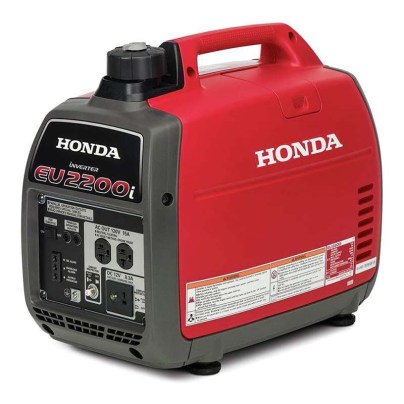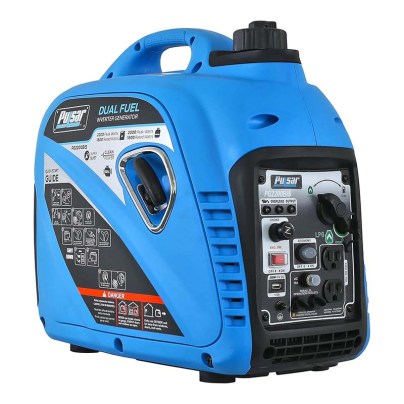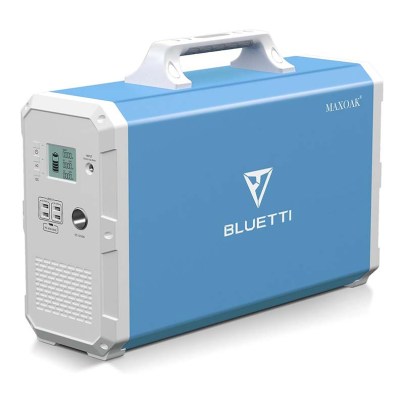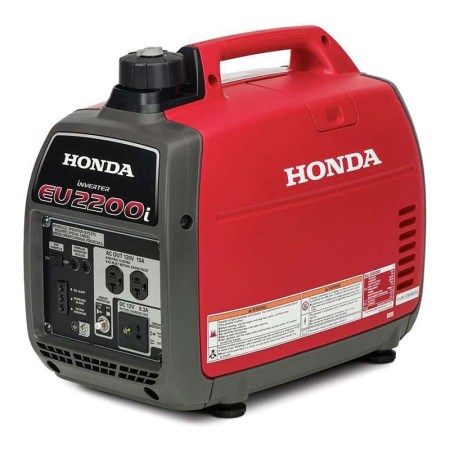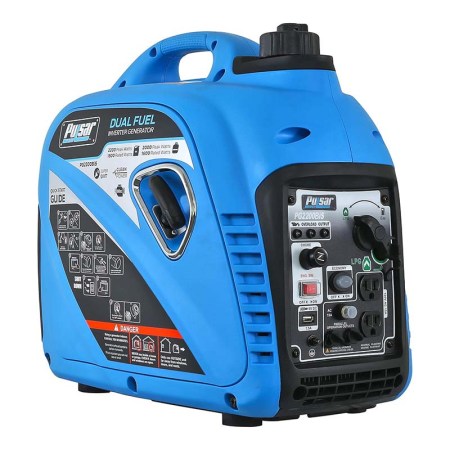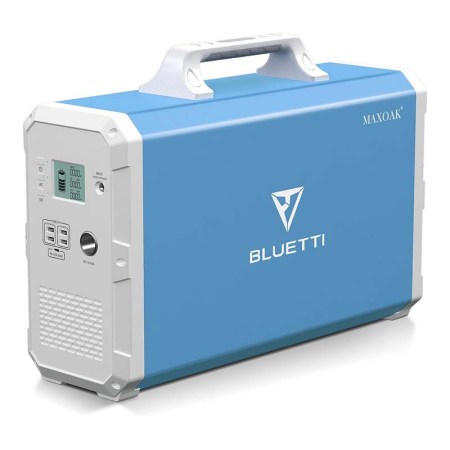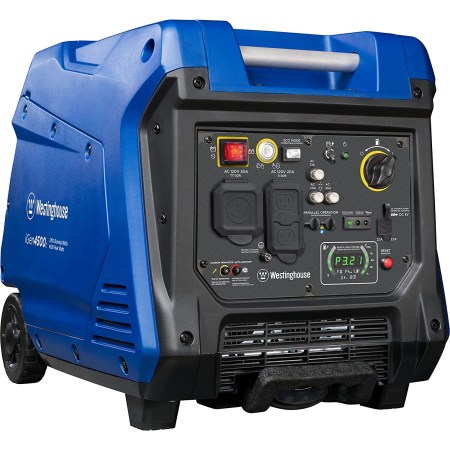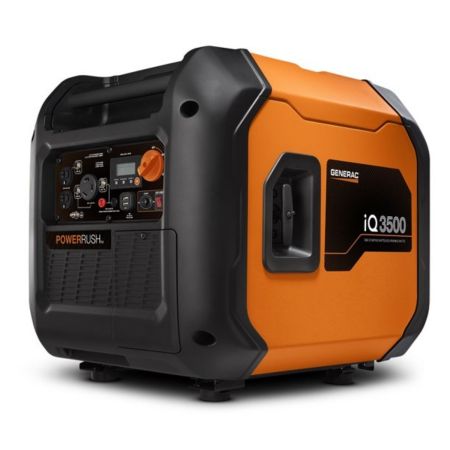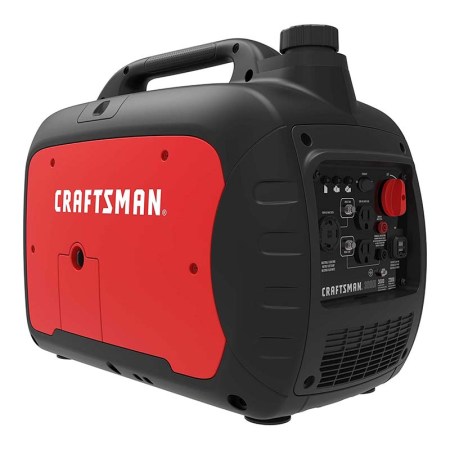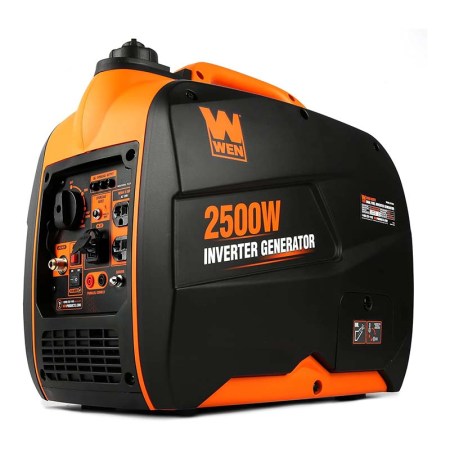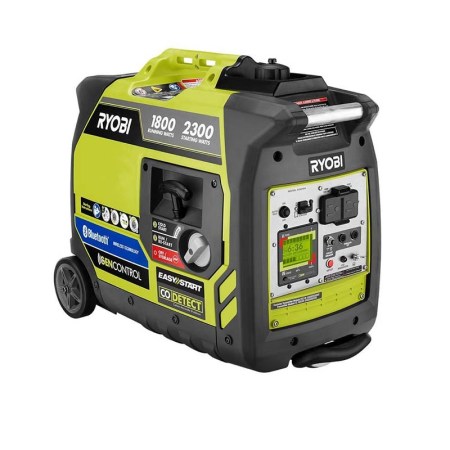We may earn revenue from the products available on this page and participate in affiliate programs. Learn More ›
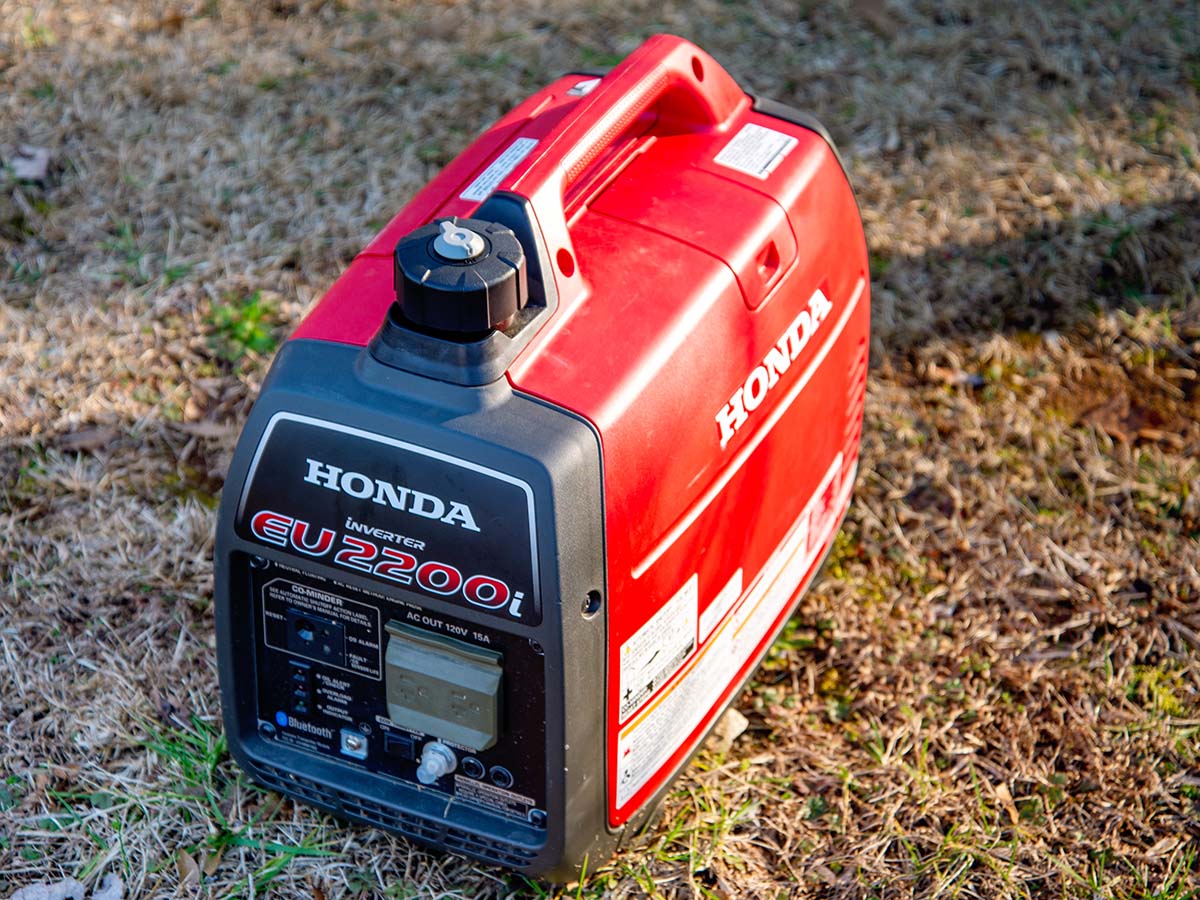
Generators provide portable electricity for emergencies, on jobsites, or even camping trips, but finding a quiet generator can pose a challenge. We wanted to find out if generators advertised as being quiet really were, so we decided to test eight best-selling models. Our goal was to determine how noisy they were and whether they were easy to use and produced adequate power. Real-life testing gave us the answers we needed to recommend these generators.
Ahead, find out how each of the following models earned a spot on our list of the best quiet generators as well as some important considerations to keep in mind when shopping.
- BEST OVERALL: Honda 2200-Watt Inverter Generator With CO-Minder
- BEST BANG FOR THE BUCK: Pulsar 2200-Watt Dual-Fuel Quiet Inverter Generator
- BEST SOLAR: Maxoak Bluetti EB240 2400Wh Solar Power Station
- BEST FOR CAMPING: Westinghouse iGen4500 Quiet Inverter Generator
- MOST USER-FRIENDLY: Generac iQ3500 Portable Inverter Generator
- BEST CARB-COMPLIANT: Craftsman 3000-Watt Inverter Generator
- BEST LIGHT-DUTY: Wen DF250i Super Quiet 2500-Watt Dual-Fuel Generator
- BEST BLUETOOTH: Ryobi 2300-Watt Bluetooth Inverter Generator
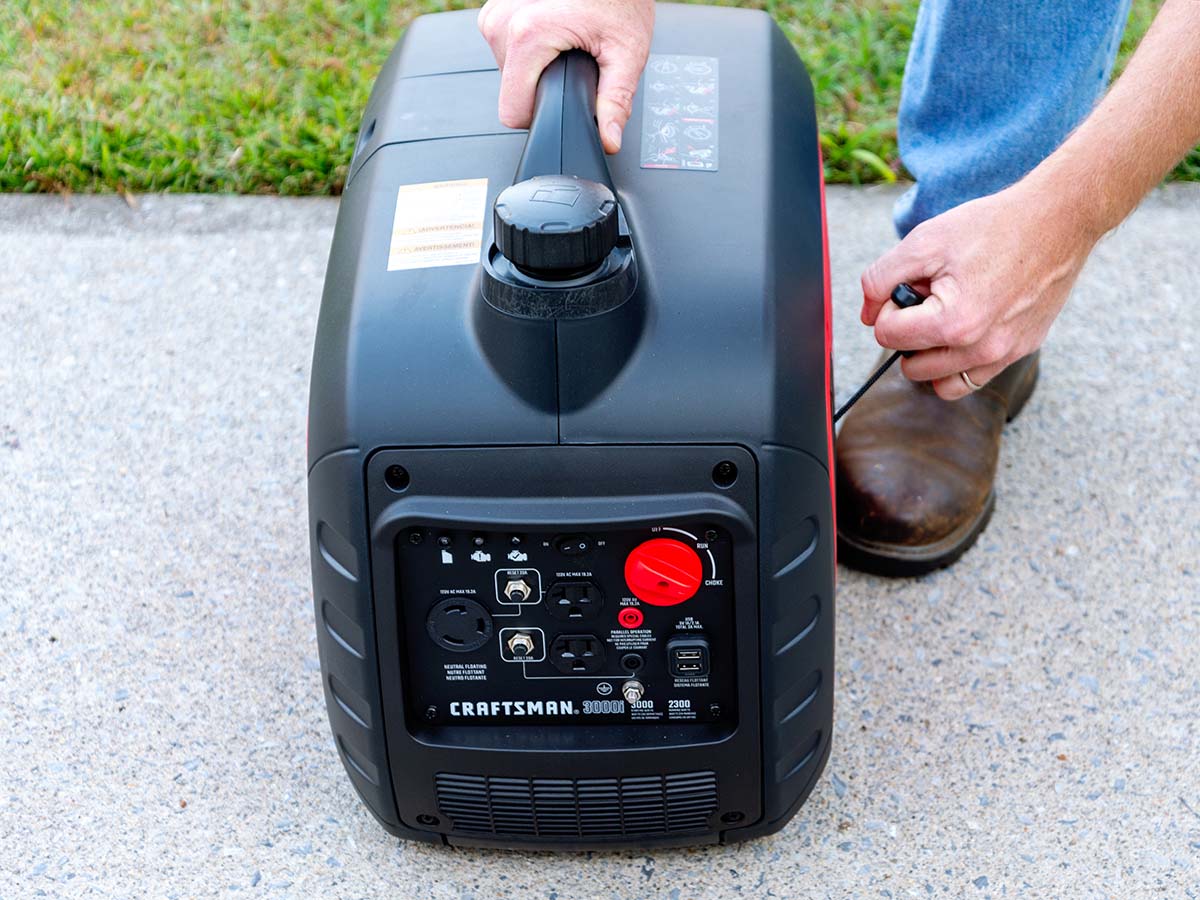
How We Tested the Best Quiet Generators
As technology improves, generator manufacturers continue to tweak their products to make them quieter and more efficient. We researched more than 35 different generators before selecting several top-rated models for hands-on testing. We considered some of the best generator brands, but we also looked at customer satisfaction, power output, cost, and noise level.
We’ve tested more than 20 generators for various guides, and as a rule, they tend to be loud, with many sounding about as loud as gas-powered lawn equipment. The quietest portable generators are typically compact computer-controlled inverters with efficient motors, advanced mufflers, and adaptable power output. While a traditional generator runs at the same speed no matter what you plug into it, an inverter generator self-regulates, which prevents wasted energy, making them among the most efficient generators.
For this list, we focused on generators with inverter engines that run at 60 decibels (dB) or less. That is about the level of a normal conversation or a running dishwasher. We also looked at solar generators, which produce little to no noise at all.
Then, the real work began. Test team members assembled the models they were assigned, carefully followed the instructions for fueling and safety, and then powered up the generators and started testing. We plugged in a variety of tools, appliances, and other items while using an online wattage calculator to help us estimate the correct wattage for each model. We paid close attention to the amount of noise the generators produced, and we also assessed ease of use, power, portability, and overall value.
Testing Stats
Products tested: 8
Hours spent testing: 83
Tests performed: 5
Average price: $798
Our Top Picks
These generators made our list by providing power for various needs without creating earsplitting noise. No matter your power needs, if you’re looking for a quiet way to generate electricity, one of these generators may very well fit the bill.
Best Overall
Honda 2200-Watt Inverter Generator With CO-Minder
See ItOur Ratings: Ease of Use 5/5; Noise 4/5; Portability 4/5; Power 5/5; Value 4/5
Product Specs
- Wattage: 2,200 peak watts and 1,800 running watts
- Noise level: 48 to 57 dB(A)
- Fuel: Gasoline
- Outlets/ports: Two 125-volt (V)-20-amp (A) outlets
- Weight: 47.4 pounds
Pros
- Whisper-quiet operation; lower noise than normal conversation
- Lightweight construction and compact build are easy to store and transport
- Powered by a reliable and easy-to-start Honda GXR120 commercial series engine
- Features carbon monoxide detection and emergency shutoff for added safety
Cons
- Not equipped with USB ports; less convenient for small electronic devices
- Premium price point for less total output than other options
The Honda EU2200i inverter generator offers an excellent combination of portability, reliability, easy operation, and low noise, making it a great option for tailgating, camping, picnics, and other on-the-go outdoor events. Though it’s not a completely noiseless generator, its engine sound easily gets lost in the background. This inverter generator has a Honda GXR120 commercial series engine that delivers 120 volts and up to 2,200 peak watts and 1,800 running watts. A 125V-20A duplex outlet allows users to plug in two electrical cords, just like a wall outlet at home.
We used it to power a full-size refrigerator for 4 hours, burning about a half tank of gas. In another test, we plugged in a portable table saw and miter saw on a jobsite for a whole workday. The current was clean and consistent, and we didn’t trip the breaker once. We also added a USB hub to charge a phone and laptop.
This generator is compatible with the Honda My Generator mobile app for remote monitoring and is parallel ready for use with a second Honda EU2200i. (Connection kit is sold separately.) It also features a built-in carbon monoxide sensor and safety shutoff. Its molded plastic handle sits behind the fuel tank opening for balanced carrying despite its nearly 50-pound weight.
Our only complaint was that there was no built-in USB port, so we had to unplug a three-prong extension cord on a tool that draws nearly 10A to charge a device using less than 3A. Still, its mix of impressive features makes this quiet portable generator a great option in a variety of scenarios.
Get the Honda quiet generator at Amazon, Lowe’s, The Home Depot, or Northern Tool + Equipment.
Best Bang For The Buck
Pulsar 2200-Watt Dual-Fuel Quiet Inverter Generator
See ItOur Ratings: Ease of Use 4/5; Power 4.5/5; Portability 5/5; Noise 4/5; Value 4.5/5
Product Specs
- Wattage: Gasoline: 2,200 peak watts and 1,800 running watts; propane: 2,000 peak watts and 1,600 running watts
- Noise level: About 60 dB
- Fuel: Gasoline or propane
- Outlets/ports: Two 120V-15A AC outlets; 1 USB-A port
- Weight: 46.5 pounds
Pros
- Light enough to move around without strain
- Easy to set up and get the engine running
- Ability to run on either propane or gasoline for increased versatility
Cons
- Access panel to change the oil was difficult to remove
- Changing the oil requires tipping the generator on its side, making it difficult to balance
The Pulsar 2200-watt inverter generator is a great option for powering small tools and devices for up to 8 hours. With a 1.18-gallon fuel tank and the ability to run either gasoline or propane, the generator supplies up to 1,800 watts while running, peaking at 2,200 watts on startup.
Setup was a bit difficult at first. To access the oil fill port we had to remove a side panel, and doing so required some manual force. Once we were able to pop the panel off, getting the generator ready to start for the first time took only a couple of minutes. With just a couple of pulls on the recoil start, the engine came to life quickly.
Our test rig included a couple of heat guns and hair dryers running at the same time on different high and low settings to vary the load. We found the generator handled 1,800 watts as advertised but noise levels were higher. Pulsar states that this generator runs at approximately 60 dB, about the sound level of conversation, but to us, it sounded about as loud as a vacuum cleaner.
Even though it was a bit louder than we hoped, we found that this generator is a great option, particularly at this price point, for light-duty power needs such as small DIY projects and powering a couple of household appliances during an outage.
Get the Pulsar quiet generator at Amazon or Walmart.
Best Solar
Maxoak Bluetti EB240 2400Wh Solar Power Station
See ItOur Ratings: Ease of Use 4/5; Power 4/5; Portability 5/5; Noise 5/5; Value 5/5
Product Specs
- Wattage: 1,200 peak watts and 1,000 running watts
- Noise level: 0 dB
- Power source: AC or solar
- Outlets/ports: Two 110V-20A outlets; 12V DC outlet; 1 PD USB-C port; 4 USB-A ports
- Weight: 48.5-pound generator; 14.3 pounds for each solar panel
Pros
- Makes no noise when used as a power source; charges via AC power at just 43 dB
- Lithium-ion polymer battery delivers a high level of stored energy in a small package
- Foldable solar panels include kickstands, mounting holes, and handles for transport
- Can accommodate over 1,000-watt start-up and running load for a washing machine with power left over
Cons
- Battery icon shows charge level rather than an exact percentage
- Two 20A AC outlets and 5 USB ports make it more suited to emergency power needs and device charging
- Operating temp is 32 to 104 degrees Fahrenheit; not compatible with extreme weather
The Maxoak Bluetti solar generator may not pack as much power as many of the other generators on this list, but in terms of a quiet, energy-efficient option for small appliances and devices, it’s a winner. It’s a virtually noiseless generator—emitting no sound when powering devices and appliances, and it measured only 43 dB when we charged via an AC outlet. This small generator weighs under 50 pounds and is just a bit bigger than a large briefcase at 19.4 inches long by 6.5 inches wide by 14.4 inches high. It has two AC outlets, one DC plug, and five USB ports, making it best suited for emergency use, portable power needs, or camping.
In testing, we used the Bluetti to run a mini fridge, corded stick vacuum, CPAP machine, and several other small appliances and cordless tool chargers. We even plugged it into a washing machine and were impressed that the generator had enough peak and running power to do a full cycle without tripping the overload protector. However, it was hard to tell how much of the battery the tests were using, as the Bluetti’s power status is displayed via a battery icon divided into five segments.
Having tested other solar generators that show an actual battery percentage, we found this pictorial representation confusing and less specific than we would have liked. Still, for 1,000 watts of power and two 200-watt foldable solar panels (with pass-through charging!), this portable silent generator is an excellent value that provides peace of mind for basic backup needs.
Get the Maxoak quiet generator at Amazon or Maxoak.
Best for Camping
Westinghouse iGen4500 Quiet Inverter Generator
See ItOur Ratings: Ease of Use 5/5; Noise 4/5; Portability 4/5; Power 4.5/5; Value 4.5/5
Product Specs
- Wattage: 4,500 peak watts and 3,700 running watts
- Noise level: 52 dB(A)
- Fuel: Gasoline
- Outlets/ports: One 120V-30A outlet; two 120V-20A outlets; 2 USB-A ports
- Weight: 104.7 pounds
Pros
- Remote control offers starting and stopping from a distance
- Eco mode saves energy when power draw is minimal
- Extendable handle and wheels make it easy for 1 person to move
Cons
- Not dual fuel; runs on gasoline only with no option for propane
Read our full review: Westinghouse iGen4500 Inverter Generator
It’s hard to beat Westinghouse’s 4,500-watt iGen inverter for power output, versatility, and portability. This gasoline-only generator has a 3.4-gallon tank that can run up to 18 hours. It operates at just 52 dB(A), which is quieter than normal conversation. This was a significant upside for us as travel trailer owners because RV parks are notorious for looking down on earsplitting generators.
This quiet backup generator offers a variety of power ports, including a 30A outlet, two 20A outlets, and two USB ports. It’s not the most powerful model we tested, but it excelled in running grinders, saws, and the electric-based essentials in a travel trailer while also charging digital devices. It weighs nearly 105 pounds without fuel, so it was challenging (but worth the effort) for just one of us to lift it into and out of the truck bed. Setting it up was a snap—we added oil and filled the tank with gas, and we were in business. W
hile this would be a great emergency generator, we think it’s one of the best quiet generators for camping, RV-ing, and remote powering.
Get the Westinghouse quiet generator at Amazon, Tractor Supply Co., or Walmart.
Most User-Friendly
Generac iQ3500 Portable Inverter Generator
See ItOur Ratings: Ease of Use 4/5; Power 4.5/5; Portability 3/5; Noise 4/5; Value 4.5/5
Product Specs
- Wattage: 3,500 peak watts and 3,000 running watts
- Noise level: N/A
- Fuel: Gasoline
- Outlets/ports: Two 120V-20A AC outlets; one 120V-30A outlet; 2 USB-A ports
- Weight: 109.1 pounds
Pros
- Equipped with an electronic push-button starter and pull-cord backup
- Eco-mode option improves fuel economy during intermittent usage
- LCD display screen for convenient monitoring of output, runtime, and fuel level
- Parallel capability means that 2 generators can be combined for double the power
Cons
- Weighs more than 100 pounds, but does not include wheels to aid transport
Although today’s quiet portable generators are much less intimidating than older equipment, their operation isn’t always as straightforward as it could be. With the Generac iQ3500, that’s not the case. It comes with a push-button starter, an easy-to-read LCD screen for monitoring power output and fuel level, and an abundance of electrical outlets.
Out of the box, the starter battery was depleted, so we pulled the recoil cord to start it. Because the product documents did not include noise ratings, we measured them with no load. In Eco mode at a distance of 5 feet, the engine noise registered 56 dB(A), and in normal mode, the reading was 61 dB(A). Even at the higher noise level, we could easily talk to one another without raising our voices. The LCD screen was easy to read and navigate. We especially appreciated the projected time left to operate on the remaining fuel level, given the current power output.
After charging the battery for an hour at idle, we shut the generator off and tried the push button. It worked perfectly. Available power outlets include a 20A duplex outlet, a 30A connection, and two USB ports. Thanks to the clean and consistent power, we had no qualms about charging our phones on the USB ports while we worked. RVers will want to take note that the 30A outlet is not “RV-ready.” The outlet on the iQ3500 is a 120V L5-30R, so an adaptor will be needed to interface with a TT-30P power cord.
At 109.1 pounds, the Generac iQ3500 is not lightweight, but it’s a small price to pay for its quiet operation, performance, and versatility.
Get the Generac quiet generator at Amazon, Tractor Supply Co., Walmart, or Generac.
Best Carb-Compliant
Craftsman 3000-Watt Inverter Generator
See ItOur Ratings: Ease of Use 4.5/5; Noise 4/5; Portability 4/5; Power 4/5; Value 5/5
Product Specs
- Wattage: 3,000 peak watts and 2,300 running watts
- Noise level: N/A
- Fuel: Gasoline
- Outlets/ports: One 120V-30A outlet; two 120V-20A outlets; 2 USB-A ports
- Weight: 59.5 pounds
Pros
- California Air Resources Board (CARB)-compliant and fuel-efficient engine causes less pollution than other generators
- Compact, lightweight construction makes it easy to pack and set up
- Assortment of power outlets supports a diverse range of electrical devices
- Parallel-ready control panel allows users to add another generator to double output
Cons
- Relatively low output and short runtime limit usage for hot-weather camping
- Single-fuel compatibility; campers must bring gasoline even if they already carry propane
Read our full review: Craftsman 3000-Watt Inverter Generator
Inverter generators are preferred for their clean voltage and quiet operation. But air quality also counts, which makes the CARB-compliant Craftsman 3,000-watt inverter generator a great option. While Craftsman doesn’t provide a spec for this generator’s noise level, we measured it from 5 feet away in Eco mode at 59 dB(A) and Normal mode at 61 dB(A). At these noise levels, it’s quiet enough for use in campgrounds and dense urban environments.
This inverter generator comes equipped with a 30A outlet suitable for powering an RV, which we did with the help of a plug adapter. However, operating at 50 percent electrical load, the relatively small 1-gallon gas tank is only enough to run 4.5 hours, which may not be enough to power an RV air conditioner through a hot night. We used the Craftsman to cool a 17-foot travel trailer from 85 to 70 degrees Fahrenheit in 1.5 hours, and it used a half tank of gas. Separately, we used it to power everything except the air conditioner (microwave, electrical outlets, and already cold refrigerator) for 1.5 hours of meal prep, eating, and cleanup. In the second scenario, it only used about a quarter tank of gas.
The Craftsman inverter generator also features two USB-A ports to support electronic devices and two ground-fault circuit interrupter (GFCI)-protected household-style three-prong outlets. With one person using those outlets to power a portable table saw and a 12-inch miter saw for intermittent cuts, the generator ran a full day on a single tank of gas.
With its low noise, low emissions, and compact portability, this quiet generator makes a good power source for a variety of off-grid applications.
Get the Craftsman quiet generator at Amazon.
Best Light-Duty
Wen DF250i Super Quiet 2500-Watt Dual-Fuel Generator
See ItOur Ratings: Ease of Use 4.5/5; Noise 4/5; Portability 4/5; Power 5/5; Value 4/5
Product Specs
- Wattage: Gasoline: 2,500 peak watts and 2,000 running watts; propane: 2,250 peak watts and 1,800 running watts
- Noise level: 52 dB
- Fuel: Gasoline or propane
- Outlets/ports: Two 120V-15A AC outlets; 2 USB-A ports
- Weight: 48.5 pounds
Pros
- Compact footprint and manageable 48.5-pound weight make it easy to move around
- 2 USB ports and 2 standard outlets can power a wide variety of devices
- Uses either propane or gas and automatically switches from one to the other
Cons
- Quick-start illustrations and user guide instructions don’t match exactly, which may be confusing
The Wen DF250i 2,500-watt is a quiet dual-fuel generator that runs on propane or gas. Switching it from gas to propane simply requires attaching a propane tank, and the machine changes automatically between the two fuel sources if one runs out. The Wen has two USB ports and two standard household outlets, which are adequate for powering a small jobsite or handling the needs of a campsite.
When we tested the generator with a circular saw that required significant power (1,500 watts), the machine bogged down briefly before ramping back up and holding steady. This didn’t happen when testing electronics with less significant power needs. Although the manufacturer suggests installing an altitude kit when using the machine at altitudes above 3,000 feet, we performed our testing without it at just over 5,000 feet and experienced no issues.
As far as noise goes, we found that it wasn’t difficult to carry on a conversation—even with the generator running just a few feet away.
Get the Wen quiet generator at Amazon, Walmart, Northern Tool + Equipment, or Wen.
Best Bluetooth
Ryobi 2300-Watt Bluetooth Inverter Generator
See ItOur Ratings: Ease of Use 5/5; Noise 4/5; Portability 4/5; Power 4/5; Value 5/5
Product Specs
- Wattage: 2,300 peak watts and 1,800 running watts
- Noise level: 57 to 68 dB(A)
- Fuel: Gasoline
- Outlets/ports: Two 120V-20A outlets and 2 USB-A ports
- Weight: 52 pounds
Pros
- Fast and easy to assemble; takes less than 10 minutes and has no complicated steps
- Convenient monitoring of the generator’s status from a distance via Bluetooth technology
- Powers a range of tools, small appliances, and digital devices
Cons
- Not suitable for powering wattage-hungry appliances such as heat presses
The Ryobi 2,300-watt gas generator was a pleasure to test. The app walked us through setup and then showed the same readings as the LED panel during operation. We liked the convenience of monitoring the generator’s status while sitting comfortably indoors and being able to turn it off using the app. You can’t start the machine that way, though, which is probably smart in terms of safety.
For our tests, we plugged in several work lights and various power tools, including a circular saw, reciprocating saw, jig saw, hammer drill, and sander. The Ryobi lagged a bit when we tried to run a table saw and didn’t provide enough juice for a heated T-shirt press, which draws high wattage. Otherwise, it met our needs. The generator is pretty quiet. We could talk easily over it without raising our voices.
While this little generator won’t power a jobsite or all the appliances in a home, it’s perfect for lower-power uses.
Get the Ryobi quiet generator at The Home Depot.
Jump to Our Top Picks
What to Consider When Choosing a Quiet Generator
There are a variety of factors to consider when shopping for a quiet generator. In this section, we take a closer look at these factors to help you find a model that provides enough power and portability at the lowest decibel levels.
Power Output
Wattage is typically the most critical factor to consider when buying a quiet generator. While generators have different wattage ratings, here’s an important point to remember: The higher the wattage rating, the higher the power output. Higher wattages usually mean larger, more expensive units (with the largest being standby generators), but quiet generators are usually compact and small, providing moderate power output for laptops, smartphones, and other small devices.
Those in the 1,000- to 1,600-watt range are great for camping and minor jobsite use, but not for home backup. For that, a minimum of 2,000 watts is recommended (to run an oven or large refrigerator), although 3,000 watts or more will be needed to run several items concurrently. Every electrical device has a label with the watts rating on it, which may help when deciding which generator to buy.
Fuel Type and Capacity
Quiet inverter generators typically use gasoline as a fuel source, and dual-fuel models can run on propane, too. This is a big advantage, as it allows you to choose fuel based on your specific needs, such as power output requirements, fuel availability in the area, and the fuel type available.
Inverter generators have an isolated gasoline tank with a fuel capacity that ranges from as small as 2 gallons to more than 10 gallons. The larger the generator fuel tank, the longer it will be able to provide gasoline-based power, but the size of the generator itself also increases.
Fuel capacity has no bearing on how much propane can be used with the generator (making propane generators worth a look for those who need versatility in these machines). Propane gas is stored under pressure in canisters, which attach to the generator with a hose and pressure regulator for direct fuel consumption.
Noise Level
Quiet inverter generators are less noisy than large or open-framed models, often in the 50- to 60-decibel range. To better understand generator noise output, here are some common comparable sounds:
- Ticking watch: 20 decibels
- Normal conversation: 60 decibels
- Hair dryer: 90 decibels
The quietest inverter generators also use sensors to detect how much power they need to expend, throttling down for smaller loads and producing lower noise levels.
We’ve included one solar generator on our list, although solar generators function differently from traditional generators. A solar generator is basically a portable power station that can be charged via solar panels, though some can also charge via an electrical outlet. Solar generators don’t produce as much energy, but they’re completely silent, eco-friendly, and can be used when no gasoline or propane is available. (Note that, like the Maxoak Bluetti above, they may make a small amount of noise when charging via an AC outlet.)
Size and Weight
Physical size and weight are also worth considering, particularly if you intend to regularly transport the generator. Since these units are meant to provide power where it is needed, small inverter generators are usually top-handled or side-handled units that can be picked up with one hand and carried with relative ease, as they’re typically around 40 to 60 pounds.
Heavier units weighing up to 100 pounds come with wheel kits to make portability easier. Both constructions are compact enough to bring to the campsite, stow in the car, or keep in the garage for when backup power is needed.
Additional Features
Quiet generators may be equipped with features that make their operation as convenient as possible. These include:
- Electric start: Instead of or in addition to using a pull cord to start a generator manually, many modern generators offer an effortless electric start. This mechanism can be in the form of a push button, a switch, and even an electric start operated by a remote control. Automatic transfer switches also fall into this category.
- Multiple outlets: Not only are multiple outlets convenient, but they also help distribute the generator’s electrical load when powering multiple devices. Having a quiet generator with at least two household electrical outlets is recommended for efficiently spreading the electrical load. Quiet generators may also have RV outlets and USB ports.
- Load sharing: Purchasing a set of the same brand of generators often provides the ability to wire them in parallel, also known as load sharing. This means that by using a brand-specific kit, owners can plug one generator into another to combine their wattages and produce even more power. Load sharing can also be a less expensive way to produce enough wattage to run large appliances or power everything in an RV at once.
FAQs
Here are some of the most frequently asked questions we get from shoppers who are looking for the best generators for their homes.
Q. What is considered quiet for a generator?
A range of 50 to 60 decibels is considered quiet for a generator. Unlike many traditional generators, which operate at loud volumes, modern inverter models are much quieter.
Q. Why are inverter generators so quiet?
Inverter generators don’t use alternators like typical open-framed models, which require the engine to work harder and produce more heat and noise. For that reason, inverter generator engines run more quietly. In addition, manufacturers can close them inside plastic housing for even better noise control without overheating.
Q. Do generators have to be maintained?
Just like your car, a generator’s engine requires periodic maintenance. This includes routine oil changes, such as after 20 hours of use for a brand-new generator and every 100 hours of use afterward, cleaning the air filter after 100 hours of operation, and ensuring that it runs for 20 or 30 minutes at least once every 3 months. Manufacturer recommendations will vary given the machine.
Q. Can I leave my generator running overnight?
It depends on the type of generator. A small portable generator may need a break from running after 8 to 12 hours (check your owner’s manual), while a standby generator is designed to run continuously if needed.
Operating a portable fuel-powered generator overnight may not be safe unless someone is awake to monitor it. While today’s manufacturers take precautions to make their generators as safe as possible, there is always a risk of fire if something flammable gets too near the generator. Additionally, fuel-powered generators produce carbon monoxide, a toxic gas that can be hazardous if inhaled. In addition to not running a generator overnight unmonitored, don’t run one in a basement, a garage, or any enclosed space. Always follow the manufacturer’s instructions for safe operation.
Why Trust Bob Vila
Bob Vila has been America’s Handyman since 1979. As the host of beloved and groundbreaking TV series including “This Old House” and “Bob Vila’s Home Again,” he popularized and became synonymous with “do-it-yourself” home improvement.
Over the course of his decades-long career, Bob Vila has helped millions of people build, renovate, repair, and live better each day—a tradition that continues today with expert yet accessible home advice. The Bob Vila team distills need-to-know information into project tutorials, maintenance guides, tool 101s, and more. These home and garden experts then thoroughly research, vet, and recommend products that support homeowners, renters, DIYers, and professionals in their to-do lists.
Meet the Testers
Mark Wolfe is a writer and product tester, focused on mechanical durability and user convenience. As a green industry veteran and an avid DIYer, he has gained valuable insight on choosing dependable power equipment, and avoiding poor-quality machinery.
Additional testing performed by Corey Foster, Austin Fracchia, Becky Helzer, Michelle Larson, and Zach Lazzari. The Bob Vila test team is made up of contractors, remodelers, home design enthusiasts, and freelancers from across the nation. Each member is dedicated to delivering high-quality product information to our readers so they can shop with confidence, knowing the products they purchase have been fully tested and vetted.
Additional research was provided by Bob Beacham and Glenda Taylor.
